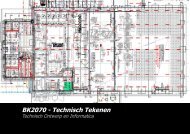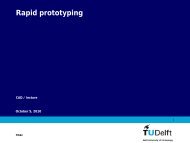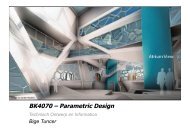Perception Aspects in Underground Spaces using ... - TOI - TU Delft
Perception Aspects in Underground Spaces using ... - TOI - TU Delft
Perception Aspects in Underground Spaces using ... - TOI - TU Delft
Create successful ePaper yourself
Turn your PDF publications into a flip-book with our unique Google optimized e-Paper software.
•= Layout <strong>in</strong>clud<strong>in</strong>g both spatial and functional organization•= Adjacency of different functions <strong>in</strong> the build<strong>in</strong>g•= Construction/structure <strong>in</strong> a sense of position<strong>in</strong>g and whether it is massive or transparent•= Dimensions of construction/structure•= Furniture position<strong>in</strong>g and design (see overview for these last three aspects)The aspects discussed up until now (A 1-4 ) are the determ<strong>in</strong>ants of public safety. Now the aspectsof comfort will be expla<strong>in</strong>ed <strong>in</strong> more detail (B 1-4 ).Wayf<strong>in</strong>d<strong>in</strong>g and orientation (B 1 )“Environmental <strong>in</strong>formation is fundamental <strong>in</strong> the mak<strong>in</strong>g of decisions and decision plans as wellas their execution. The provision of adequate environmental <strong>in</strong>formation is furthermore a crucialdesign issue. Signs, maps, verbal descriptions, as well as architectural and urban spaces can beseen as <strong>in</strong>formation support systems to wayf<strong>in</strong>d<strong>in</strong>g” (Pass<strong>in</strong>i, 1992, p. 76).Orientation is one of the important aspects for an underground build<strong>in</strong>g especially due to a factthat there are not so many reference po<strong>in</strong>ts and limited relation with the surface. This togethermakes it more difficult to understand one's position <strong>in</strong> space.“Disorientation is not only an <strong>in</strong>convenience – it is potentially quite stressful… One key isdesign<strong>in</strong>g an environment with ‘imageability’, a term that refers to ‘the ease with which a placecan be mentally represented’. These mental images can be <strong>in</strong>corporated <strong>in</strong>to an overall cognitivemap to ma<strong>in</strong>ta<strong>in</strong> orientation” (Carmody and Sterl<strong>in</strong>g, 1993, p. 193).Lynch classifies five elements that are relevant for the city image, be<strong>in</strong>g paths, edges, districts,nodes and landmarks (Lynch, 1960). Although the elements that Lynch considers are for the city,some parallels can be made and applied to the build<strong>in</strong>gs (Carmody, 1993). Pass<strong>in</strong>i (1992) whostudied the wayf<strong>in</strong>d<strong>in</strong>g <strong>in</strong> underground space draws these parallels as well. He def<strong>in</strong>ed them <strong>in</strong>the follow<strong>in</strong>g way:•= Paths are the circulation system, which <strong>in</strong>cludes corridors, promenades that are part ofhorizontal circulation and stairs, elevators and escalators that are part of vertical circulation.•= Walls <strong>in</strong>side the build<strong>in</strong>g could be viewed as the edges•= Districts are considered to be certa<strong>in</strong> areas with specific functional characteristics•=•=Nodes are def<strong>in</strong>ed as important circulation <strong>in</strong>tersections, halls and <strong>in</strong>door squaresLandmarks are a clearly remembered element such as particular shop, sculpture or decorativeelements. Accord<strong>in</strong>g to Pass<strong>in</strong>i, not only objects but also the space itself, can serve as areference po<strong>in</strong>t, and could be considered a landmark.These five elements all together can contribute to the imageability and therefore contribute to theformation of a cognitive map. Cognitive map represents “an organization of the physicalenvironment <strong>in</strong> simplified form” (Pass<strong>in</strong>i, 1993, p. 40). Evans (1981) showed that the landmarksare used as <strong>in</strong>itial anchor po<strong>in</strong>ts <strong>in</strong> the environment and by connect<strong>in</strong>g these landmarks <strong>in</strong>tonetwork a path structure is formed. In addition, the exact location of the landmarks improves withexperience. This means that <strong>in</strong> time a cognitive map improves and becomes more accurate.Follow<strong>in</strong>g aspects can have a role <strong>in</strong> determ<strong>in</strong><strong>in</strong>g wayf<strong>in</strong>d<strong>in</strong>g:•= Layout – the above mentioned elements are organized through layout•= Adjacency – closeness of different functional groups and dist<strong>in</strong>ction between them- 33 -





